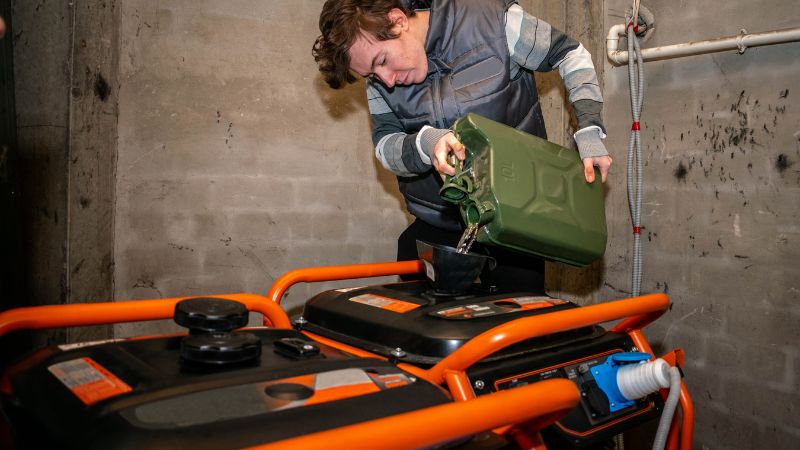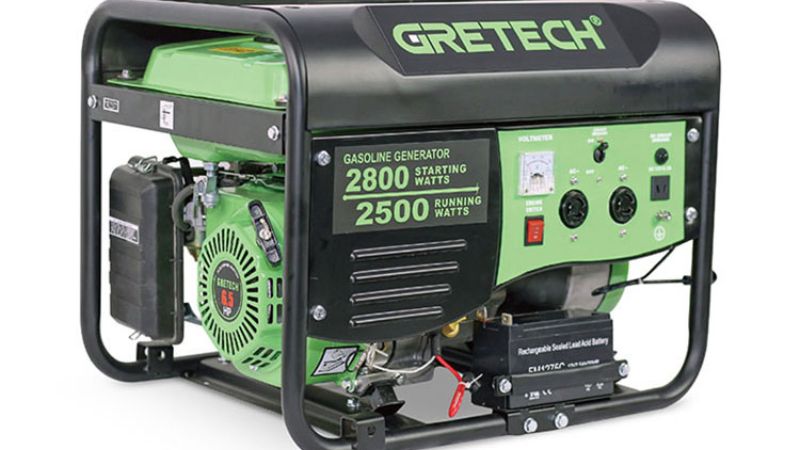You should never put gas in a generator while it’s running. Doing so is dangerous and can cause fires, burns, or even explosions. It’s important to let your generator cool down before adding fuel. Understanding why this is so important can help you avoid risky mistakes and keep your generator working properly.
If you want to learn more about the best ways to refuel your generator and why safety guidelines matter, just keep reading. This guide brought to you by Gretechpower will explain what you need to know.
Safety Risks of Refueling a Running Generator
Refueling a generator while it is on can be dangerous. Fuel like gasoline or diesel is highly flammable, and even a small ignition can cause a serious fire hazard.

Fire Hazard From Gasoline Vapor
Gasoline could be volatilized into vapor that you often cannot see or smell right away, which would catch fire if it come in contact with hot parts, sparks, or static electricity from the generator.
During a refueling process, the engine and exhaust could be easily ignited if vapor touch these surfaces, starting a fire or even leading to an explosion. Therefore, you should always turn off and cool down the generator before adding fuel to avoid these risks.
Burns and Injuries
Pouring fuel into a running generator can cause you to accidentally come into contact with hot metal surfaces. Exhaust pipes, engines, and even gas tanks can become extremely hot in minutes. If you get too close, you can burn your hands, arms, or face.
There is also a risk of spilling gasoline on skin. Since it can not only irritate your skin but also cause severe burns if it catches fire. A fire can start so fast that you have little time to react or get away.
Take extra care when handling gasoline containers as well. Some containers may slip if your hands are sweaty or wet, which adds to injury risk. Remeber to use heat-resistant gloves and wait for the generator to cool down.
Impact of Spilled Fuel
Spilling fuel on or around a hot generator is risky. Gasoline can flow onto hot engine parts or the ground, increasing the chance of a fire. Even small spills may start burning before you notice.
Dangers from spilled fuel include:
- Creating fire hazards on surfaces
- Damaging electrical components if fuel seeps inside
- Making the area slippery and unsafe to walk on
Cleaning up spilled gasoline is not simple. The strong smell, fumes, and risk of fire make it unsafe to ignore. Always use caution and never refuel over hot or running equipment to prevent these problems.
Proper Steps for Refueling a Generator
When it is time to add gas to your generator, following the right steps helps prevent fires, burns, and accidents. Always focus on safety so your generator keeps working well and does not create danger for you or those nearby.

Shutdown Procedures Before Refueling
You must always turn off the generator before you add fuel. Let the generator run without a load for a few minutes to cool down a bit before shutting it off. This helps lower the engine temperature.
After turning the generator off, switch off all connected devices or unplug them. Make sure all moving parts have stopped fully. If your generator has a fuel valve, close it to prevent leaks.
Allowing the Engine to Cool
Refueling a hot generator can be very risky. Gasoline vapor needs time to dissipate, and immediately refueling a generator after it is shut down is still not recommended.
Wait at least 10–15 minutes after shutting the generator off before opening the gas cap. This gives the engine, muffler, and fuel tank time to cool down. After that, place your hand near the engine, and if you still feel heat emitting from the casing, wait longer. Only refuel when the area around the gas tank feels cool.
Choosing Safe Refueling Locations
Always move your generator to a safe, open space before refueling. You need to be in a spot with plenty of airflow so dangerous fumes do not build up. Never refuel indoors, in garages, or under shelters where gasoline vapor could collect. Refuel away from open flames, pilot lights, or electrical devices that could start a fire.
Keep a fire extinguisher or a bucket of sand nearby when refueling. Avoid letting gas drip or spill onto the generator or ground.
Alternatives to Refueling While Running
It is dangerous to add gas to a generator while it is on. There are safer ways to keep your power going without putting yourself at risk.

Backup Power Options
Having a backup source of power can keep your devices running during a generator refuel or maintenance. Some top backup choices include:
- Uninterruptible Power Supply (UPS): Protects computers or small electronics from brief outages. UPS units give you a few minutes to safely switch power sources.
- Battery Banks: Store electricity for when your generator is off. Some battery packs have enough power for several hours of light use.
- Second Generator: If demands for voltage are high, a second generator can run while you turn off the first. This works well for homes with medical equipment needing steady electricity.
Using backup systems prevents downtime and protects your devices. With pre-charged batteries or a UPS, you can refuel your main generator without stressing over lost power.
Extended Run Fuel Systems
Extended run fuel systems let your generator operate longer without frequent stops for refueling. These systems include:
- External Fuel Tanks: Larger tanks connect directly to your generator. You fill the external tank, not the generator itself, providing several hours or even days of run time.
- Automatic Transfer Switches (ATS): Some setups include an ATS, which can safely switch between different power sources when needed.
- Dual-Fuel Generators: These can use more than one type of fuel, like gasoline or propane. Propane tanks may last longer and are easier to swap out than filling a gas tank by hand.
Frequently Asked Questions
How long should one wait before refilling a generator after it has been shut off?
You should wait at least 15 to 20 minutes after shutting off a generator before adding gas. This allows the engine to cool and reduces the risk of gasoline igniting from contact with hot parts. Always check that the generator is cool to the touch before refueling.
Is it safe to move a generator while it is operating?
It is not safe to move a generator while it is running. Moving a running generator can cause fuel spills, electric shock, and mechanical damage. Always turn it off and let it cool before moving.
How many continuous hours can a generator run before needing to be refueled?
Most portable generators can run for 6 to 12 hours on a full tank of gas, depending on their fuel capacity and the load they are handling. Check your generator’s manual for the specific run time and refueling guidelines. Remeber never try to refuel while the generator is operating.
